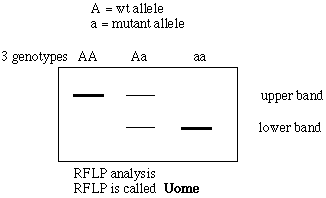
Fall 1998 Biology 111 Exam #3 - end of genetics + Bioenergetics
There is no time limit on this test, though I have tried to design one that
you should be able to complete within 2.5 hours, except for typing. You
are not allowed to use your notes, old tests, or any books, nor are you
allowed to discuss the test with anyone until all exams are turned in at
9 am on Tuesday November 23. EXAMS ARE DUE AT CLASS TIME ON MONDAY November
23. You may use a calculator and/or ruler. The answers to the questions
must be typed on a separate sheet of paper unless the question
specifically says to write the answer in the space provided. If you do not
write your answers on the appropriate pages, I may not find them unless
you have indicated where the answers are.
Please do not write or type your name on any page other than this cover
page. Staple all your pages (INCLUDING THE TEST PAGES) together when
finished with the exam.
Name (please print):
Write out the full pledge and sign:
How long did this exam take you to complete (excluding typing)?
Lab Questions:
6 pts.
1) Design an experiment using the Ames test to determine whether DDT is
mutagenic or not. You must use two strains of cells and you also want to
determine what affect 30 seconds of UV light might have on DDT's ability
to be mutagenic. Make sure you tell me all the controls you would perform
as well.
4 pts.
2) Why did some strains have different rates of spontaneous reversion
if they all shared the exact same DNA polymerase alleles? For example,
the spontaneous reversion rate for 1535 was about 20 while 102 was closer
to 250.
Lecture Questions:
6 pts.
3) a) What is a restriction enzyme made of?
b) What is its substrate?
c) What is the product?
6 pts.
4) What is the molecular cause for HD?
10 pts.
5) Generate a genetic linkage map from these data
about a dominant disease:

142 individuals were AA and had only the upper band
9 individuals were AA but had both bands
11 individuals were aa but had both bands
138 individuals were aa and had only the lower band
a) How many people had the disease?
b) What is the map distance between the disease locus and the RFLP locus?
c) What would you tell a couple whose fetus was tested and had only the lower band?
4 pts.
6) Why did investigators need to do chromosomal walking if they could
use cDNA as a probe for CF or exon amplification for HD? Why not skip over
chromosomal walking since it takes so long?
4 pts.
7) If chlorophyl a (the pigment in the reaction center) can only absorb
blue and red light, then why don't leaves look orangy-yellow?
6 pts.
8) Define (as positive or negative) the DG, DH and DS of the light reaction.
6 pts.
9) Tell me what the 3 final products of the light reaction are and how each
is produced.
8 pts.
10) What is consumed in the dark reaction and what is produced?
4 pts.
11) In this reaction, is this molecule being oxidized or reduced? To get
credit, you must explain your answer.

4 pts.
12) What role does Rhizobium play in the life of a soy bean plant?
Is nitrogen fixation reduction or oxidation when ammonium is produced? Explain.
8 pts.
13) List all the different reducing agents produced during cellular respiration
and how much is produced from one glucose molecule.
List the processes within cellular respiration which produce these reducing agents.
6 pts.
14) Plants consume water, CO2, and O2. Where and why are each of these consumed?
We do not consume one of these three, which one and why?
6 pts.
15) What is cyclical about the citric acid cycle? Explain in general terms
how carbons cycle through this pathway.
6 pts.
16) List the three carbon-based products of fermentation, excluding ATP and NAD+.
Which one or ones do you think Clostridium tetanii produces in us and why?
4 pts.
17) Facultative anaerobes need a control mechanism that repsonds to the
presence or absence of oxygen. Develop a reasonable hypothesis which describes
how such an organism can switch from anaerobic metabolism to aerobic. There
are several correct answers to this question but keep your answer short
and limited to only one hypothesis. Note that it is worth only 4 points.
2 pts.
18) Why would anaerobic bacteria not be harmed by either cyanide or paraquat?
+2 pts possible but no points lost
Bonus Question:
Why do people get dizzy when their blood glucose levels drop even though there is plenty of protein and lipids available for catabolism in the brain?